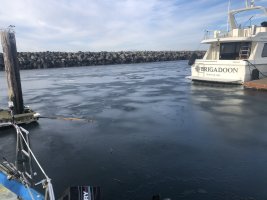Puget sailor
Member II
I would expect freshwater cooling system in the engine to be using anti-freeze just like a car. Assuming that's true, it should be fine.
As for seawater that circulates through heat exchanger etc, that's more complicated. Puget Sound is salt water, so it will freeze, but not with conviction of fresh water, and not until lower temps. If in the river down in Portland, perhaps there is more circulation which might mean higher surface water temps and potentially more radiant heat coming up through the hull? I'd look for any evidence of freeze damage in anything with water in it, especially engine heat exchanger and raw water pump, hoses, through hull, etc. You might get lucky. I think part of the challenge with my boat is transom cowl vents facing wind. I did put blue tape over my dorade vents last trip to the boat to cut down on cross ventilation of cold air. I'd also suggest after checking boat, running engine, etc, hang around for half an hour after shutting it all down and look for leaks before taking off. Water lift muffler is another thing to check before starting the engine if in fresh water. Hopefully it's low enough to benefit from hull temp, plus it's not contained water, so it could freeze without breaking potentially. Don't forget the head too.
As for seawater that circulates through heat exchanger etc, that's more complicated. Puget Sound is salt water, so it will freeze, but not with conviction of fresh water, and not until lower temps. If in the river down in Portland, perhaps there is more circulation which might mean higher surface water temps and potentially more radiant heat coming up through the hull? I'd look for any evidence of freeze damage in anything with water in it, especially engine heat exchanger and raw water pump, hoses, through hull, etc. You might get lucky. I think part of the challenge with my boat is transom cowl vents facing wind. I did put blue tape over my dorade vents last trip to the boat to cut down on cross ventilation of cold air. I'd also suggest after checking boat, running engine, etc, hang around for half an hour after shutting it all down and look for leaks before taking off. Water lift muffler is another thing to check before starting the engine if in fresh water. Hopefully it's low enough to benefit from hull temp, plus it's not contained water, so it could freeze without breaking potentially. Don't forget the head too.


